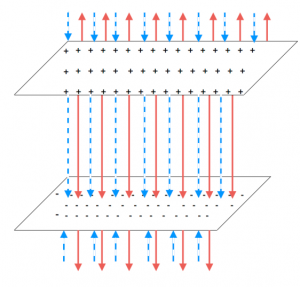Section 19.1 in Matter and Interactions (4th edition)
Capacitors in a Circuit
As you read about, capacitors can be charged in a circuit and discharged through a resistor or lightbulb; thus, providing energy or powering a lightbulb for very short amounts of time. It turns out that this is a very useful circuit element and can be used for a variety of purposes in circuits. For example, a capacitor is used to provide power for a camera flash, provides a back up power supply for a computer (so it has enough power to properly shut down if it runs out of battery), and filters out background noise from a video or sound recording. However, when we start to talk about capacitors in larger circuits like this, it becomes difficult to talk about what is happening to every electron around the circuit or the individual electric fields. Instead, we define macroscopic measures like potential difference and capacitance to talk about the role that these capacitors play in circuits.
Definition of Capacitance
Capacitance is defined as the proportionality constant of the potential difference between the plates of the capacitor (|ΔV|) and the amount of charge that is on one plate (|Q|) - if the charge increases, the potential difference should increase and vice versa. Note that since one plate will always have a charge of +Q and one will have a charge of -Q (because of conservation of charge), the |Q| will be the same no matter which plate you are looking at. In terms of an equation, this means that: |Q|=C|ΔV|
Finding Capacitance
We can actually find an expression for capacitance specifically for parallel plates using the relationship between electric field and electric potential and the definition of capacitance above. Assume we start with a pair of parallel plates, which have an area A, a charge of +/−Q, and are separated by a distance d.
Deriving the Capacitance for Parallel Plates
We start by considering the electric field between the plates. We know that for two parallel plates, there is an electric field in the middle that points directly from the positive plate to the negative plate (except near the edges where the field bends slightly out). Outside of the plates, the electric field is zero because the contributions from the negative and positive plates will cancel. This means that there is a very strong electric field in the middle of the plates and a very small electric field outside the plates. If we assume that the area of the plates is very large compared to separation between them, then the electric field between the plates is approximately constant. It turns out that the magnitude of this electric field is related to only the charge density (charge per area) on the plates assuming that the charge density is uniform and the ϵ0 constant. We represent the charge density with a σ:
|→E|=QAϵ0=σϵ0
We will actually derive where this relationship comes from later in the course. If we choose a coordinate system, where down is the -y direction, then the electric field vector would be: →E=−σϵ0ˆy
Now that we have the electric field between the two plates, we can find the potential difference between the plates using the relationship between electric field and electric potential. ΔV=−∫rfri→E⋅→dr
Because we assumed that the charge density was uniform, σ is a constant, just like ϵ0. So the integral becomes quite simple: ΔV=σϵ0∫d0dy=σϵ0(d−0)=σdϵ0
Once we have the potential difference across the plates, we can use the definition of capacitance to find the capacitance of the parallel plates: C=QΔV
Since σ is the charge density of the plate, we can rewrite it in terms of the charge and area of the plate: σ=Q/A. So we get a capacitance of: C=Qϵ0QAd
Dielectrics
What would change about our capacitance expression if we added a dielectric insulator in between the plates? As we talked about before, adding a dielectric allows more charge to pushed onto the plates of the capacitor for a certain voltage. If we think about that in terms of the capacitance equation Q=CΔV, this means that the proportionality constant (really the capacitance) should increase if a dielectric is added.
This is generally achieved by adding a constant to the capacitance called the dielectric constant. This constant is really a “constant” as it is highly dependent on temperature and material, but large resource tables exist for finding the dielectric constant of various materials at various temperatures. The dielectric constant is usually represented by a “k” and is unitless. The typical range of a dielectric constant is somewhere between 1-100. So the capacitance equation for a parallel plate capacitor with a dielectric would be given by: C=kϵ0Ad
Energy in Capacitor
We can also use capacitance to think about how much energy a capacitor is able to store based on the amount of charge on the plates. Remember that the general relationship between electric energy and electric potential is U=qV. We can start to find the energy in the capacitor by saying we want to know the small amount of energy it would take to move a small amount of charge from one plate to another. Mathematically this would be: dU=Vdq
Examples
-
- Video Example: Energy Stored in a Parallel Plate Capacitor
-
- Video Example: Finding the Capacitance of a Cylindrical Capacitor
